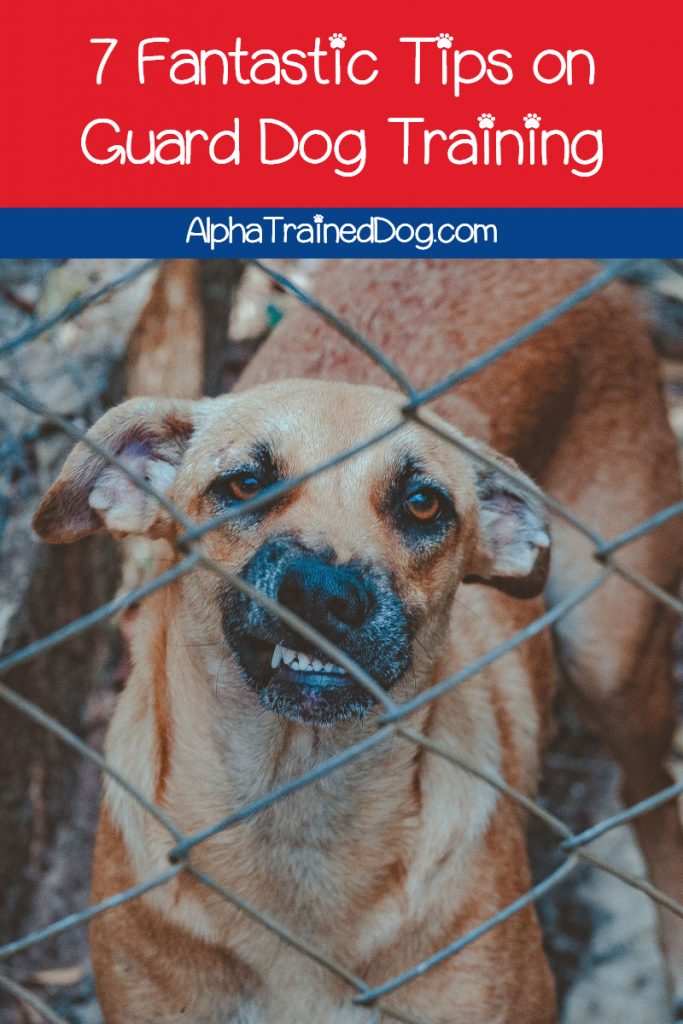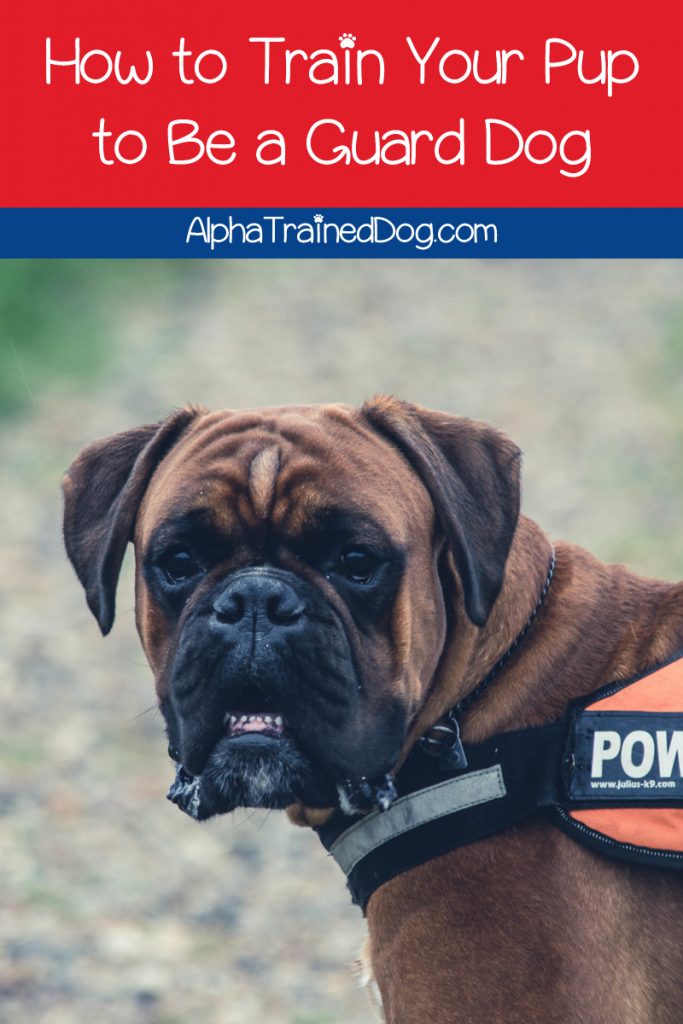Do you think that your dog will make an excellent watchdog, but you don’t know a thing about guard dog training?
Then, don’t worry because I’ve got your back with some amazing training tips and tricks.
Just keep reading to discover how to guard train your dog.

7 Tips on Guard Dog Training
Let me make something clear. We aren’t going to talk about how to teach your dog to attack on command. That’s because attack dog training requires a lot of experience, confidence, and knowledge to do it right.
Done poorly, your dog will attack without warning and can cause serious damage to friends and foe alike.
Moreover, some people might misuse such information and apply it to train their dogs for fighting.
But more importantly, it’s very unlikely that you’ll need an attack dog.
So what we’re going to talk about is how to train your dog to alert you about the presence of strangers and friends around the house.

#1 Determine If Your Dog Is Suitable for a Guard Dog
Before you start training your pet to be a watchdog, you have to determine how suitable they’re for the job.
Some breeds make poor guard dogs because they are happy to meet strangers and make friends quickly.
These dogs would rather welcome any thief with a wagging tail than bark to chase them away.
On the other hand, we have breeds that are naturally suspicious of strangers and take time to warm up to visitors.
These dogs make excellent watchdogs because they’re territorial and protective. I’m talking about German Shepherds, Doberman, Akita, Chow Chow, and Shar-Pei, among few.
That being said, you can try to teach a friendly dog breed to be a guard dog. However, it will be more time-consuming and might not yield the same results.
#2 Learn What Makes a Good Guard Dog
Despite what you might think, a guard dog doesn’t react to strangers out of fear or anxiety.
Guard dogs are confident, curious, and assertive. They’re smart enough to be wary of strangers, but they should never express aggression towards them.
The ideal guard dog should never be timid or shy around new people or surroundings.
Instead, they should have a wait and see approach to new situations. It goes without saying, but guard dogs should be loyal and protective of their territory and owners.
In addition to this, the best guard dogs are easy to train. Some breeds make excellent watchdogs, but they’re so hard to train that you’re left wondering if it’s worth the efforts.
#3 Socialize Your Dog
As I already said, the ideal guard dogs aren’t timid or afraid of unfamiliar people. A scared dog is likely to run or fight, and that’s not what you want from a watchdog.
So, your first step in guard dog training is to socialize your dog as much as possible.
The best period to do is between 3-12 weeks of age because the puppy is still curious about the world and open to new experiences.
Socializing your dog will also help your pooch understand what constitutes a threat and what not.
Otherwise, your dog will noise for the slightest disturbance or whenever they’re afraid or anxious.
To socialize your dog, you should expose them to as many new experiences as possible.
Organizing a socialization party or enrolling in puppy obedience classes are excellent ideas.
Moreover, once your puppy has their shots, you can bring them with you around malls, shops, and parks.
#4 Start Obedience Training
One of the most important things when it comes to guard training is obedience.
Your pooch should obey all your commands without hesitation, no matter what’s happening around both of you.
That will ensure that you can control your dog’s behavior and prevent escalations.
So, while you’re socializing your puppy, you should also focus on obedience training.
Start with the basic commands and work on each one until your puppy has mastered them completely. Be patient and use a lot of positive reinforcement to make training fun for your pet.
It’s never too late to train a dog, but the sooner you start, the easier it will be.
#5 Teach “Bark” and “Quiet”
Since a good guard dog barks whenever they hear something strange, you should teach your dog to be silent on command. Otherwise, your pooch might bark endlessly and drive you crazy.
Interestingly, to teach a dog the silent command, you have to train them to bark on command first. Here’s how to do it:
- Pick a barking trigger, something that makes your dog bark. Usually, the doorbell works.
- Get your dog to sit, use your trigger, and wait for the dog to bark.
- The moment that happens, say “Speak,” and toss a treat.
- Keep practicing until your dog starts to bark whenever they hear “Speak.”
- It might take you several weeks to master the command, so you should be patient with your dog. Remember to praise and reward as much as possible.
Once you get your dog to bark on command, it’s easy to teach them to be quiet:
- Say “Speak” and wait for your pooch to bark.
- Place a treat beneath the nose and say, “Be quiet.”
- When the dog stops barking, you should praise and reward them immediately.
- Keep practicing by adding distractions and distance to the command.
- Eventually, your dog should stop barking even if you’re not in the room when you give the command.
#6 Encourage Your Dog to Bark
Usually, you don’t want your dog to react when somebody is at the door.
However, when you’re training a guard dog, you have to teach your dog to announce strangers.
By nature, most dogs will bark when someone is standing in front of the door. So, all you have to do is encourage this behavior.
Whenever your dog barks to announce a stranger, make a show of checking the perimeter.
Give your dog the “Be quiet” command and then praise and reward them.
Your goal is to show your dog that you appreciate their warning and that you take them seriously.
If your dog doesn’t bark when somebody is at the door, you give the “Speak” command.
Eventually, your dog will get it that they’re supposed to make noise when you have visitors outside.
Don’t encourage barking outside your home. You don’t want your dog barking at strangers during your walks, so use your commands to curb any unwanted or excessive barking.
In this way, your pooch will know when they should bark and when not.
In addition to this, remember that your dog can’t distinguish between friend and foe.
So, don’t discourage your dog to bark when friends come over. While you might know who is at the door, your dog doesn’t.
#7 Organize a Mock Break-In
To build your dog’s confidence as a guard dog, you can ask a friend to come over and attempt to break into your house.
When the dog sees the “burglar” and starts barking, your friend should look at the dog and then flee as fast as possible.
Praise and reward your dog immediately and tell them what an excellent job they have done.
Don’t let the dog chase the person under any circumstances. You don’t want to establish aggression as an acceptable response.
Guard dog training is a serious endeavor. You have to be prepared that it will take weeks or months until your dog knows what you expect from them.
As in all training, it’s important to encourage the behavior you want to be repeated and ignore/punish the one you don’t.
But if you notice any aggression in your dog during training, you should stop and consult a professional trainer.


Trackbacks/Pingbacks